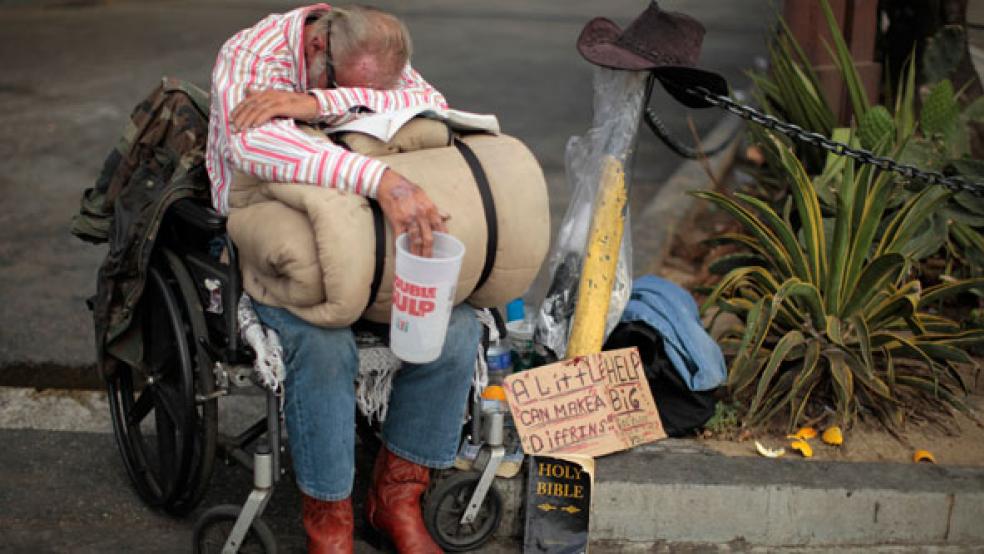Get ready for the next big financial bubble—the growth of America’s homeless population.
The biggest boon for the homeless was President Obama’s 2009 stimulus package, that appropriated $1.5 billion to the Homeless Prevention and Rapid-Re-Housing Program that temporarily aided homeless and near-homeless households. According report issued Wednesday by the National Alliance to End Homelessness, the program has helped more than one million impoverished individuals find housing, but it is set to end this fall.
“The resources provided by [the program] have run out in many communities … and the debt and deficit at the federal level have already begun to shrink assistance available to the most vulnerable,” Nan Roman, president and CEO of NAEH, said at a news conference. “The failure to sustain this early recipe for success threatens to undermine progress now and in the future.” A separate report from the same organization released in September noted that the ranks of the nation’s homeless could swell by five percent over the next three years if no similar programs replace the program.
The View from the Street
Veda Simpson, a former methadone addict, was homeless for ten years, living in shelters, crack houses and what she dubbed “abandominiums” in public housing complexes. Then last year, thanks to a federal housing voucher, she moved into an apartment in Washington, D.C.’s North Capitol area.
“I used to go in the kitchen and fit my body up under the sink in the cabinet—you have to adjust your body to get up under there—and I used to have to sleep in there so security wouldn’t find me,” Simpson told the Fiscal Times. “I slept in there for about six months, and it was rough.”
Simpson, a vendor for StreetSense, a daily newspaper about the homeless, is one of thousands of people who managed to get off the streets and into housing in recent years, despite one of the worst recessions in modern history, according to experts and homeless advocates. Now she lives in subsidized housing with her eight cats, and says she is two months away from earning certification as a veterinary technician through an online program. “It’s really hard being homeless,” she said. “I don’t see nobody who wants to continue like that. They’re trying to better themselves.”
There are glimmers of good news about the homeless. The NAEH report found a slight decrease in the overall number of people living on the street between 2009 and 2011 -- the ranks of the nation’s homeless fell by one percent, or about 7,000 people.
Across the country, 636,017 people were identified as homeless in 2011 compared to 643,067 in 2009, according to the Departments of Housing and Urban Development, Justice, Labor, Commerce and Health and Human Services.
With the troubling spectacle of homeless people and panhandlers loitering on street corners of downtown areas in many cities, it’s hard to imagine that the problem of homelessness is actually waning. The NAEH study cautions that the plight of the homeless is likely to grow more acute because of low-paying jobs, high housing costs and the loss of emergency federal assistance.
Double-Up Trouble
One of the report’s chief findings is that the number of people “doubling up”—living with friends, family, or nonrelatives—rose by more than 50 percent between 2005 and 2010, and 13 percent between 2009 and 2010. Those arrangements are the most common gateway to homelessness, and the increases mean more people are getting to that “last stage” before they are forced onto the streets, Roman said. “Doubled-up people have an elevated risk of homelessness….Thirty percent of all homeless shelter residents and 44 percent of adults in families who use homeless shelters were doubled-up prior to entering the shelter system,” the report said.
Rep. Gwen Moore, D-Wis., told reporters that children are bearing the worst of the emotional brunt of “doubling up,” and many of them show that by acting up in school.
“The homeless people I see are not alcoholic, drunk men lying on a grate—the stereotype of a homeless person,” said Moore, a member of both the House Budget and Financial Services Committees. “They’re kids who live with grandma one weekend, the other grandma the next, auntie the next week, moving from school to school to school.”
The report also highlights the fast rising number of poor households that are devoting more than half their income to rent. Those families and groups are highly vulnerable to losing their housing in the coming years, the report stated. Between 2007 and 2010, there was a 22 percent increase in the number of these so-called “severely housing cost burdened” households.
Shamekia Murray knows this situation all too well. She couldn’t keep up with her rent payments after she was forced to accept a $15,000-a-year pay cut at her Washington, D.C. community health clinic job. She and her then-five-year-old son were evicted from their apartment and her car was repossessed.
Murray and her son slept on friends’ and family members’ sofas for eight months, while she continued to hold down her job as a dental assistant. “I wasn’t used to having to ask someone, ‘Can I borrow $20 to pay for the Metro subway?’ I was used to turning the key in my own home, having family gatherings, and having my son sleep in his own bed. “All that got taken away from me in less than a year,” she added. “It got to the point where I just broke inside.”
Murray, now 33, sought transitional housing for eight months to get on her feet before going out on her own. She recently received a job promotion, and now rents a two-bedroom apartment. “It’s a matter of knowing what it is that you want, and knowing that you’re not ever going to go back,” she said.






